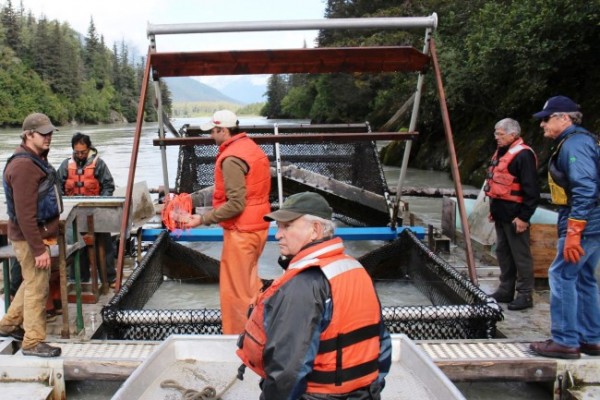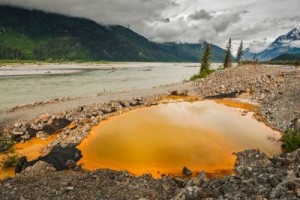Canadian regulators say the Tulsequah Chief Project, about 40 miles northeast of Juneau, has agreed to reduce pollution leaking into a nearby river. But the controversial project won’t have to restart a shuttered water-treatment plant many Southeast Alaskans want back in operation.

The British Columbia copper, zinc, silver and gold mine closed in 1957, after 20 years of operation. But in recent years, two companies have developed plans to reopen it.
In the meantime, acidic water bearing metals dangerous to fish has been draining into the Tulsequah River. That flows into the Taku River, which hosts rich salmon runs caught by Alaska and B.C. fishermen.
Current owner Chieftain Metals Corp. did install pollution-control equipment several years ago, but shut it down because of its high cost. Critics in Alaska want the provincial government to force the company to start it up again.
But at least for now, that’s not going to happen.

“There are things that that company can do short of firing up a full water-treatment plant at that site that will make a difference,” says Bill Bennett, British Columbia’s minister of mining and energy.
His agency and two others recently notified the Tulsequah Chief Mine that it’s out of compliance with its provincial permits. Bennett says he met twice with the mine owners, who indicated they would comply.
“We have asked them for a plan showing us how they would make some changes there that would alleviate some of the issues such as the spilled oil and in some cases some water going directly into the river. There are ways that they can divert that water. They can put it through settling ponds. There’s a number of things they can do,” he says.
Chris Zimmer of Rivers Without Borders says that’s not enough.
“This is just kind of putting a Band-Aid on the issue or kind of dancing around the margins,” he says.
Zimmer says diverting more mine water into settling ponds won’t do the job. That’s because they’re small and will eventually overflow.
“So essentially what Bennett is saying is, ‘We’re going to do a few minor things around here. But the biggest problem of this direct discharge of polluted water into the river, we’re not going to be able to do anything about,’” he says.

Bennett says his government is not giving up on the water-treatment plant. It’s told mine owners to prepare a plan for reactivation within 90 days.
But he says forcing that to happen now could push Chieftain toward bankruptcy.
“We want this company to be able to build a mine there so that they can operate this water-treatment plant and pay for the improvements that are necessary,” he says.
The news comes as state and provincial leaders work on agreements giving Alaska a larger role in transboundary mine regulation.
Lt. Gov. Byron Mallott recently formed a citizens’ advisory panelthat’s helping draft a document to be submitted to B.C. officials. Bennett says he’s already discussing some of its proposals.
Advisory panel member Rob Sanderson Jr., who co-chairs the United Tribal Transboundary Mining Work Group, is one of its members.
“I would hope that they would take our concerns to heart here in Southeast Alaska and start cleaning that mine up before they move on any other projects,” he says, adding that he doubts B.C. is sincere in its mine-safety promises.
Bennett visited Chieftain Metals’ Tulsequah site in August, as part of meetings with state officials and regional business and community leaders. Afterward, he said what he saw was unacceptable and needed to be fixed.
But then, as now, he cited studies he said show no long-term damage.
“The indications are from all the tests that have been done by both sides, both Alaska and B.C., that what’s happening today is not endangering the water or aquatic organisms,” Bennett says.
Critics say those tests are incomplete – and inaccurate.
“There’s been no comprehensive studies. There is no scientific agreement that there’s not a problem. The studies haven’t been done,” says Zimmer, of Rivers Without Borders.
He cites research showing dangerous amounts of copper and zinc, which harm fish.
“The most recent study commissioned by Chieftain found levels of copper at the mine site exceeding B.C. standards by a thousand times. Levels of zinc, 2,000 times. A mile and a half downstream of the mine, copper and zinc are still four, five, six times over the water quality standard,” he says.
In addition to Alaska critics, the Taku River Tlingit First Nation opposes mine development.
Tulsequah Chief’s owners could not be immediately reached for comment. The Chieftain Metals’ website did not appear to include any response to the provincial notices of violation or criticism from Alaskans.
Ed Schoenfeld is Regional News Director for CoastAlaska, a consortium of public radio stations in Ketchikan, Juneau, Sitka, Petersburg and Wrangell.
He primarily covers Southeast Alaska regional topics, including the state ferry system, transboundary mining, the Tongass National Forest and Native corporations and issues.
He has also worked as a manager, editor and reporter for the Juneau Empire newspaper and Juneau public radio station KTOO. He’s also reported for commercial station KINY in Juneau and public stations KPFA in Berkley, WYSO in Yellow Springs, Ohio, and WUHY in Philadelphia. He’s lived in Alaska since 1979 and is a contributor to Alaska Public Radio Network newscasts, the Northwest (Public Radio) News Network and National Native News. He is a board member of the Alaska Press Club. Originally from Cleveland, Ohio, he lives in Douglas.




